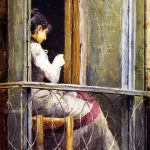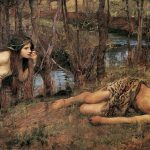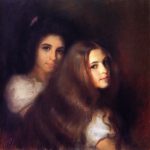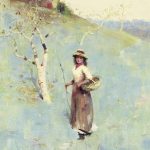
Roberts painted a considerable number of fine oil landscapes and portraits, some painted at artist camps with his friend McCubbin. Perhaps the most famous in his time were two large paintings, Shearing the Rams, now displayed in the National Gallery of Victoria and The Big Picture, displayed in Parliament House, Canberra. The Big Picture, a depiction of the first sitting of the Parliament of Australia, was an enormous work, notable for the event depicted as well as the quality of Roberts’ work.
Shearing the Rams was based on a visit to a sheep station at Brocklesby in southern New South Wales, depicted the wool industry that had been Australia’s first export industry and a staple of rural life. When it was first exhibited, there were immediately calls for the painting to enter a public gallery, with a Melbourne correspondent for the Sydney press stating, “if our national gallery trustees were in the least patriotic, they would purchase it.”
Some critics did not feel that it fitted the definition of ‘high art’. However, since the wool industry was Australia’s greatest export industry at the time, it was a theme with which many Australian people could identify. In this painting, as one modern reviewer has said, Roberts put his formal art training to work, translating “the classical statuary into the brawny workers of the shearing shed”.
Roberts made many other paintings showing country people working, with a similar image of the shearing sheds in The Golden Fleece (1894), a drover racing after sheep breaking away from the flock in A break away!, and with men chopping trees in Wood splitters (1886).
Focus On Small Works
Many of Roberts’ paintings were landscapes or ideas done on small canvases that he did very quickly, such as his show at the famous 9 by 5 Impression Exhibition in Melbourne, “9 by 5” referring to the size in inches of the cigar box lids on which most of the paintings were done. Roberts had more works on display in this exhibition than anyone else.
In 1888 Roberts met Conder in Sydney and they painted together at Coogee beach. The younger Conder found these painting expeditions influential and decided to follow Roberts to Melbourne later that year to join him and Streeton at their artists’ camp at Heidelberg.
While Conder painted Coogee Bay emphasising on the decorative qualities of form and colour, Roberts’ Holiday sketch at Coogee(1888) embodies his primary focus on the landscape’s natural effects. It is an early testament to Roberts’ plein-air ‘impressionist’ technique, which brought out the sun’s glare on the bright blue sea, bleached white sand, dry grass and spindly seaside vegetation. Source: Wikipedia.






